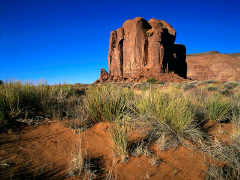|
Leave Only Footprints
The Art of No-Trace hiking
Many people are using the backcountry these days. It has become quite popular to spend a day or even a few weeks in the Wilderness. Because of this, there has become an increased need for people to leave as little impact as possible. There are many brochures and books about this, I just thought I'd add my own two cents.
Take Pictures, Not Souvenirs
When you are visiting the Wilderness, you should never disturb anything that you can avoid disturbing. Don't cut trees for firewood; don't take that interesting looking rock you found as a souvenir. The Wilderness belongs to the animals, you are only a visitor there, so please respect it. Instead of removing things, take pictures of it. That way you can remember the place the same way as the next person will.
Pack It In, Pack It Out
If you pack it in, you can pack it out. Don't throw food wrappers or anything else away. Carrying food wrappers, used batteries, etc is not any extra weight in your pack. Also, pack out as much trash you find on the trail and at camp as is practical. Leave the Wilderness in better condition than you found it.
Sanitation
Use existing restrooms whenever possible, when not available, dig a cathole. All catholes should be at least 200 feet from any water source. Water sources include: streams, lakes, gullies( seasonal streams), springs, etc...
If you must bathe while you are out on a hiking trip, don't use any soap, not even biodegradable, it still has an impact on the environment. Generally, it is OK to bathe in a stream, but be sure not to use it as a toilet. If you don't want to sit in a stream to bathe, fill a waterbag with water and use it to rinse yourself off.
As for washing dishes, avoid using any soap. A way that works well is to boil water in a pot, and use the hot water to sterilize the dishes after food crumbs are wiped off. If you have a pot that needs to be washed, simply boil water in it, and then scrape all food out of it. Rinse it out, then let it dry.
Fire
If you can avoid doing so, never light a fire. Taking firewood leaves less natural material to be converted into duff. This in turn can affect the growth of future generations of plants. It also can prevent a future party from starting a fire in an emergency.
Fireless campsites can even lend a bit of discovery to the evening. You may see animals roaming around that would otherwise be frightened by the fire. And you'll be able to see plenty more stars. Not to mention the fact that fires are illegal in many Wilderness areas.
If you must cook, use only backpacking stoves that do not require any natural fuels. Buy the most fuel effecient one that you can find, as this will also cut down on pollutants put out into the atmoshpere.
Minimizing Trail Damage
When you walk on trails, you leave evidence of your passage in the form of footprints( or more accurately, shoeprints). The size of the lugs on the soles of your shoes directly affects the impact you have on the trails. There are many ways to minimize this impact that will be discussed in the following paragraphs.
Simply put, bare feet leave the least trace possible. The print left by a bare footprint is far less than that left by any type of footwear. Many people are somewhat aghast at the thought of going barefoot outside of their own homes. You can, however, accustom you feet to all sorts of surfaces. You don't need any support whatsoever if you accustom your feet and ankles to walking in a natural style.
Wear the lightest boots that you can possibly wear on a given trail. If you don't need heavy hiking boots for your trip, don't wear them. Many people suggest that you always need heavy boots for long hiking trips. This is generally not true, because you can condition your feet to wearing lighter footwear.
I personally hike either barefoot, in sandals, or in running shoes. It all depends on the weather, how far I'll be hiking, and what the terrain is like. Only in the winter, when I'm on snowshoes, would I consider heavy weight boots. But this conditioning comes only after several years of hiking( and walking in general) barefoot and in sandals. Also, by carrying a lighter pack, I can get away with wearing lighter footwear.
Camping
When choosing a campsite, always choose the sight that will have the least impact. When possible, camp on a rock( a large flat one), on dirt, or on sand. These places are very hard to damage in any way. Never camp in a meadow, or on forest duff( unless you cannot avoid doing so), these areas show damage much easier than others.
Camp as far from other people as you can. By doing this, you can avoid noise and visual pollution to their campsites. You can also avoid bears by doing this. Bears know where people usually camp, and frequent those areas to get food.
There are several ways to avoid bears in your campsite. One, don't cook your food anywhere near your campsite. This reduces odors that will attract bears to your food. Two, camp away from pre-existing campsites. The bears know where to look for food, and they look where everyone else camps. By camping away from these spots, you generally can avoid bears. Three, camp above tree line when you can. There are usually few bears up there, because there is almost no naturally occuring food there.

|




